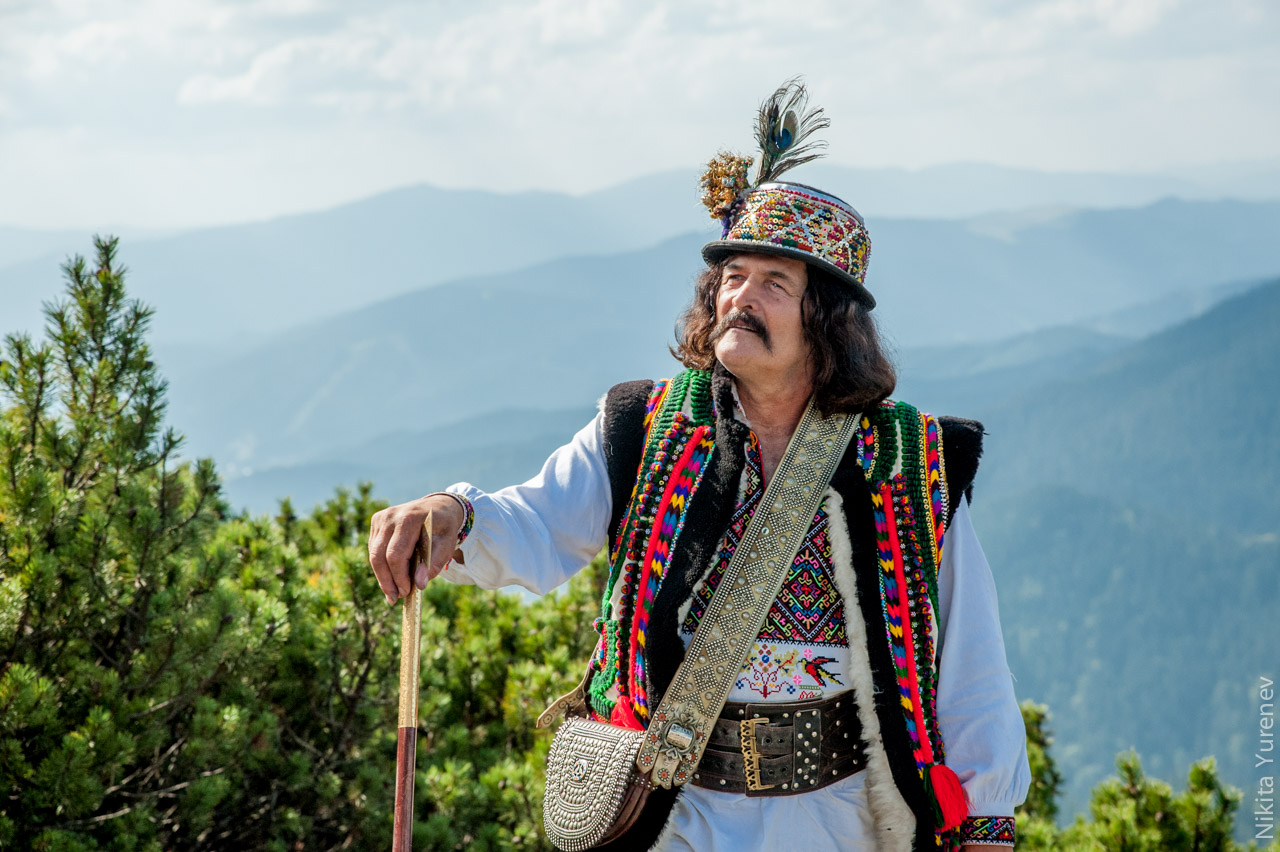The Hutsul Land is the symbol of abundant life in every way it can be abundant. The pristine beauty of the Carpathian Mountains, forests and lakes created the lifestyle pattern of the Hutsuls. All the spheres of everyday life and folklore traditions of the Carpathian Druids absorbed the art of living in harmony with nature and feeling it alive even in grass and stones. Colorful Hutsul clothing is also soaked with the beauty of the surrounding. Vivid natural colors of the Carpathians found their reflection on embroidered shirts, keptars (traditional Ukrainian sleeveless jackets) and women’s headscarves. The voice of waterfalls took shape in the melodious sound of rich women’s jewelry; ornamental patterns on the clothing depict the starry sky, Carpathian sun and spring exuberance of polonynas. Severe mountain climate and dynamic lifestyle that required protection from forces of nature gave rise to functionality and a utilitarian attitude in outfits. Most Ukrainian regions have the ethnic costume as a museum showpiece, but on the Hutsul Land, on the spiritual and ecological oasis of Ukraine, some long-standing traditions are still preserved in people’s everyday life.
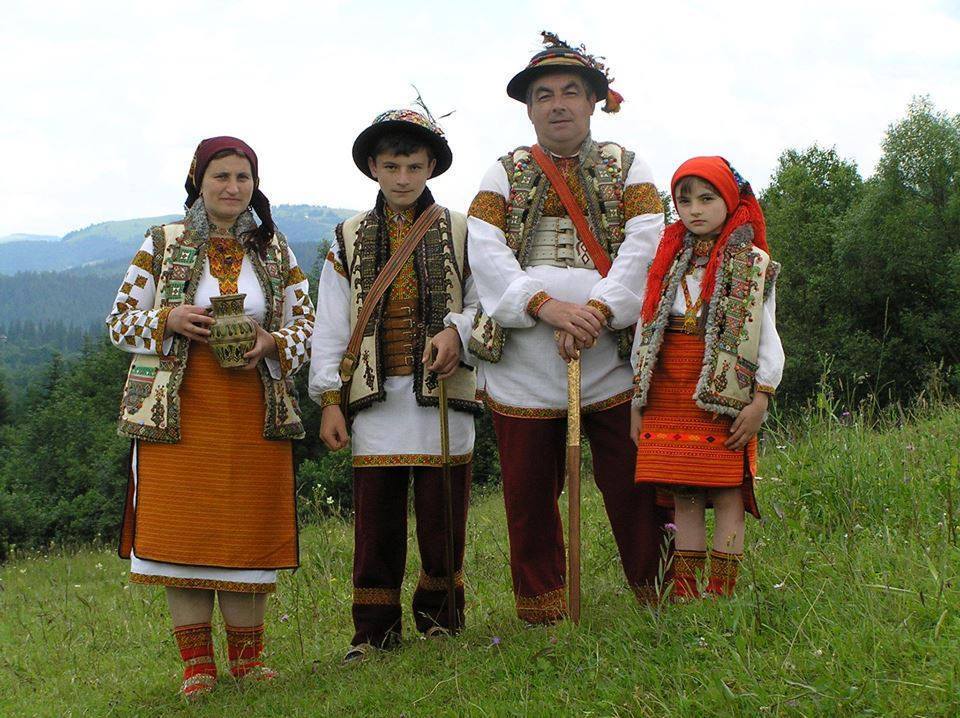
Thinking of the Hutsul costume a picture depicting a festive-dressed couple in bright clothes comes to your mind; a man wearing a hat with a feather and topirets (a kind of an ax in the Hutsuls) and a woman wearing a headscarf with tassels and a necklace. Do you want to learn the genuine names of the Hutsul clothing and accessories? If yes, this short and sweet intro into their clothing will be extremely beneficial to you!
You may be interested in bus tours to Bukovel
What do the Hutsuls wear on their heads?
The hat with a feather mentioned above is genuinely called “krysania”. And they decorated the summer felt headwear not only with the feather of a wood grouse but also with colorful lacings, artificial flowers and wool tassels. In winter, men used to wear a “horny hat”, a spectacular hat made of black sheepskin. Girls wove wool yarn through their hair, and married women tied a patterned woven wimple on their heads.
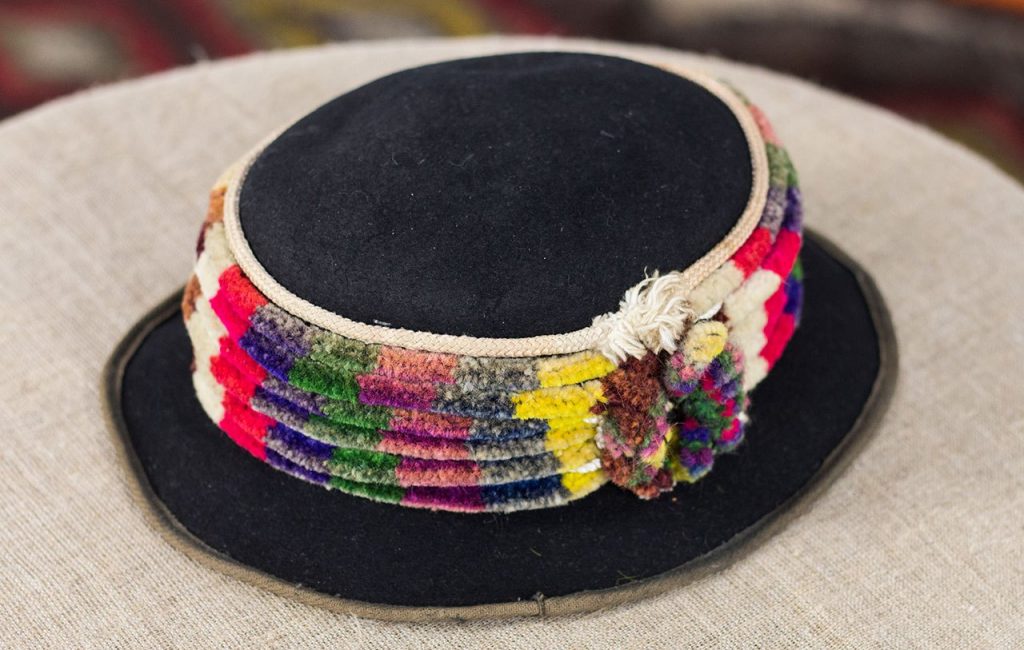
The Hutsul “burden”
To sew clothes, they used only natural materials, such as wool, leather and fur. Man traditionally wore embroidered band-collared and bishop-sleeved shirts. Their trousers were also designed with embroidery. Woolen cloth “hachi” (woolen cloth trousers) served as a variation for winter, or red-colored “krashenytsi” (red woolen cloth trousers). In summer the Hutsuls wore white “portinytsi” (white linen trousers) made from linen. Socks made from wool – “kapchury” or “onuchi” (black or red) were decorated with colorful ornamental design. The Hutsul fur-lined sleeveless jacket, well-known beyond the borders of the area, is called “keptar”. It is decorated with leather applications, embroidery and different metal décor elements. Outdoor clothing, “sardak”, was also decorated in a fancy manner, with tassels, colorful lacing, worsted buttons and sewed with colorful thread over the stitches.
Women’s outfits were way more exuberant. The basic wardrobe included shirts decorated with vivid and massive embroidery in cold colors, zapaskas (a kind of a rectangular apron) woven in horizontal wool lines with glossy metal-like threads, ornamented and spectacularly decorated fur jackets (keptars) and sardaks.
Everyday clothing comparing to festive outfits, shirts, especially, were a little reserved in colors and trimming.
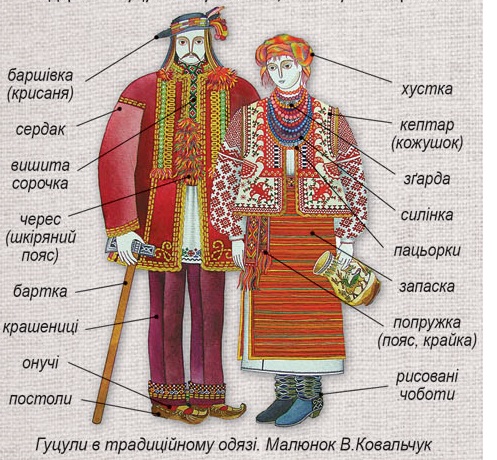
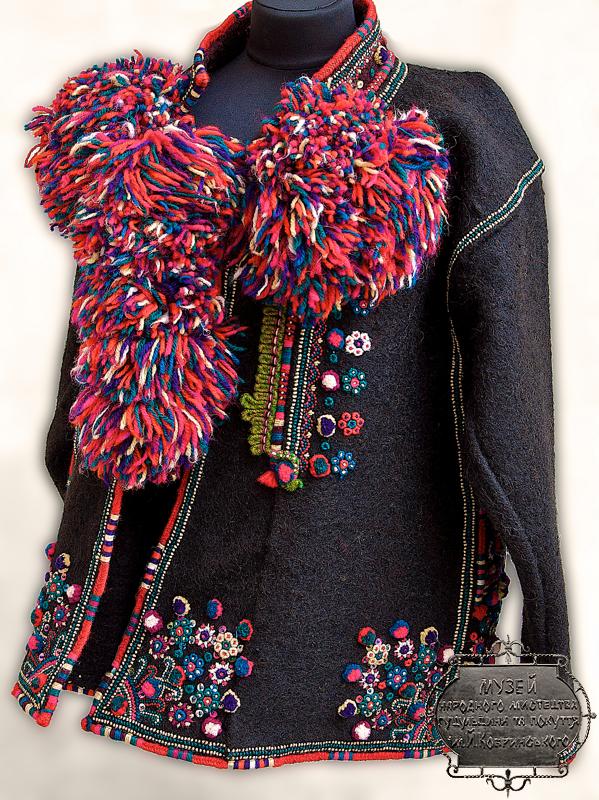
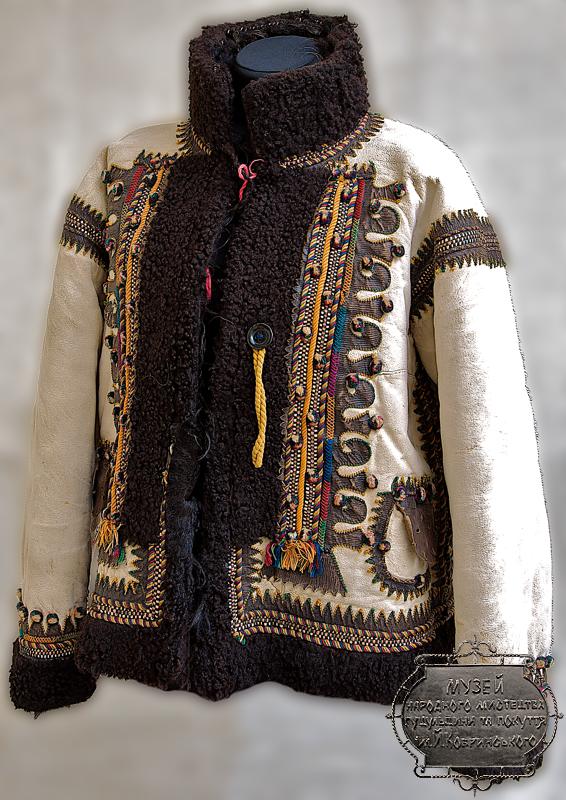
“Rysovani” boots
The durable leather footwear of the Hutsuls was characterized by the complexity of the fit and diverse elements. “Postoly” (traditional Ukrainian sandals) with pointed toe, made from one-pieced calf or pig skin, was the most used footwear till the beginning of the 20th century. Authentic “rysovani” boots with the corrugated lower part of the boot-top were worn by the Hutsuls as well. They used wool insoles to make the footwear coldproof. It is widely thought the higher the boots were, and the bigger number of décor elements the boots had, hence, the richer men wore them.
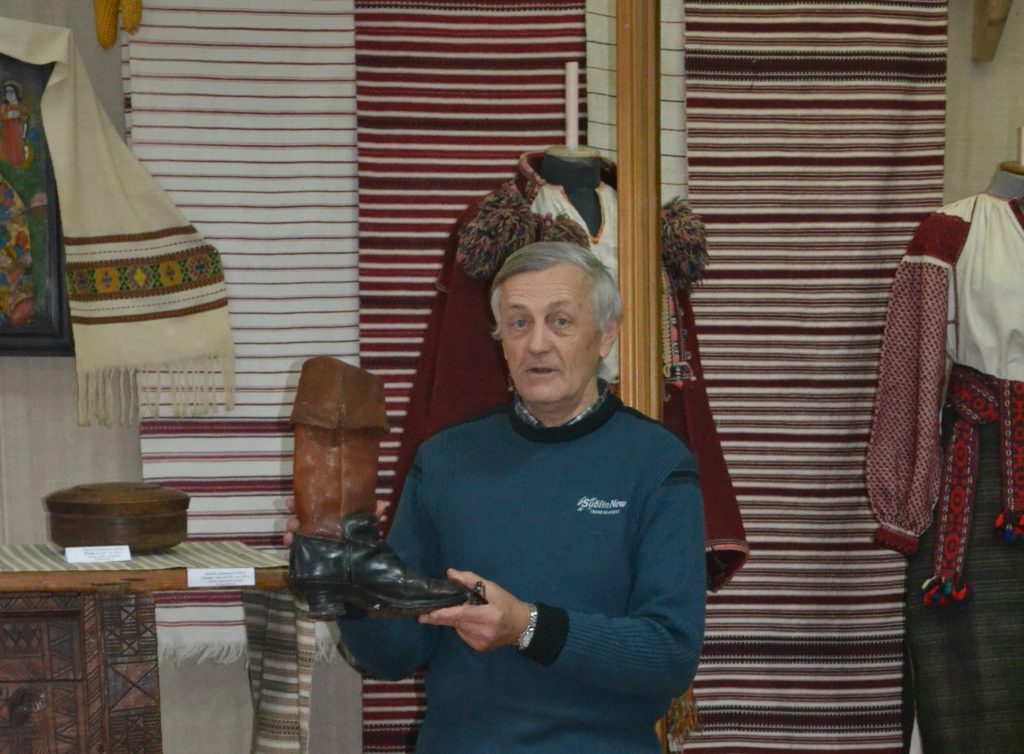
Accessories and jewelry
Men gird themselves with a leather belt of different width called “cheres”. It was decorated with stamping and brazing metal plates. They attached a fire striker, a pipe, protychka (an instrument to clean a pipe), and a needle case to a cheres. Common male accessories included also decorated powder flask and a leather bag (“torbivka”), or a woolen taistra (a cross-body bag). Traditionally men wore a brassy cross on their breast; quite often one could notice a topirets, “bartka”.
Female belts, called “popruzhnyk”, served as a sort of corset. Natural female beauty was brought out by kovtoks (earrings), rings on their fingers and copper or woolen bracelets. However, the bulk of female accessories were worn on their necks. “Zgarda” (neck jewelry) made of metal coins and little crosses, open-worked “syliankas” and “gerdans” made from different-colored beads (“patsiorky”), silver dukach necklace, natural and artificial corrals made the exuberant and rich ensemble.
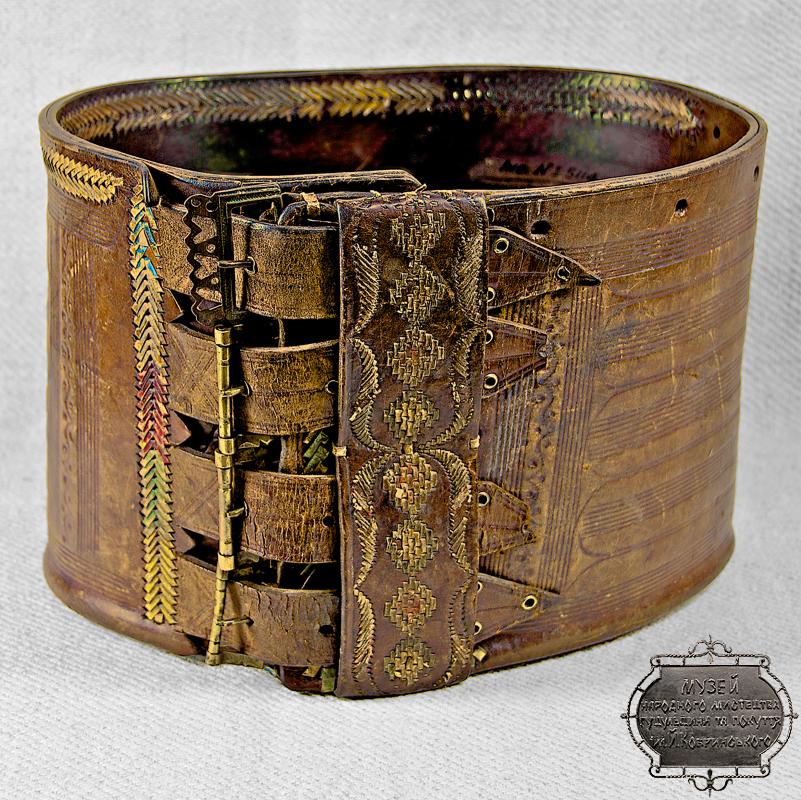
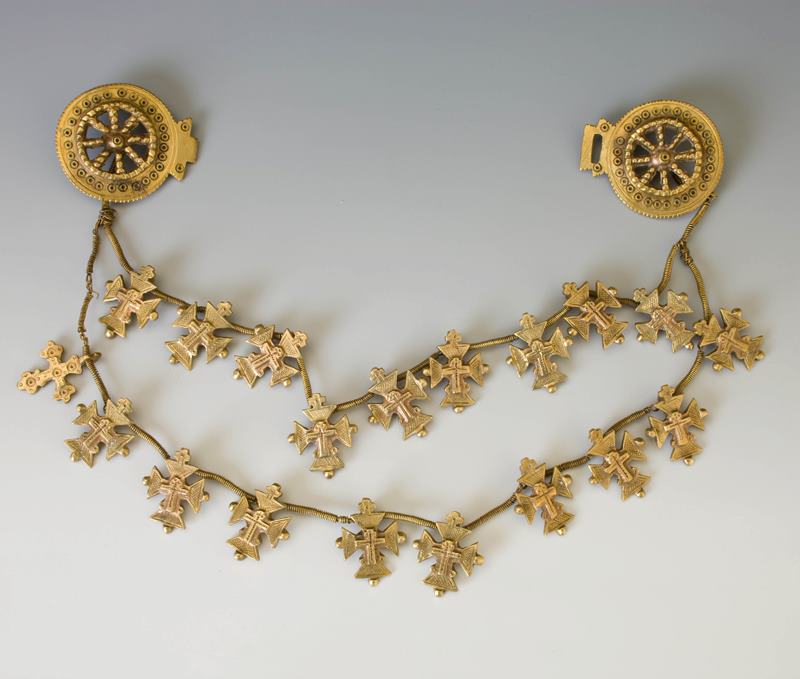
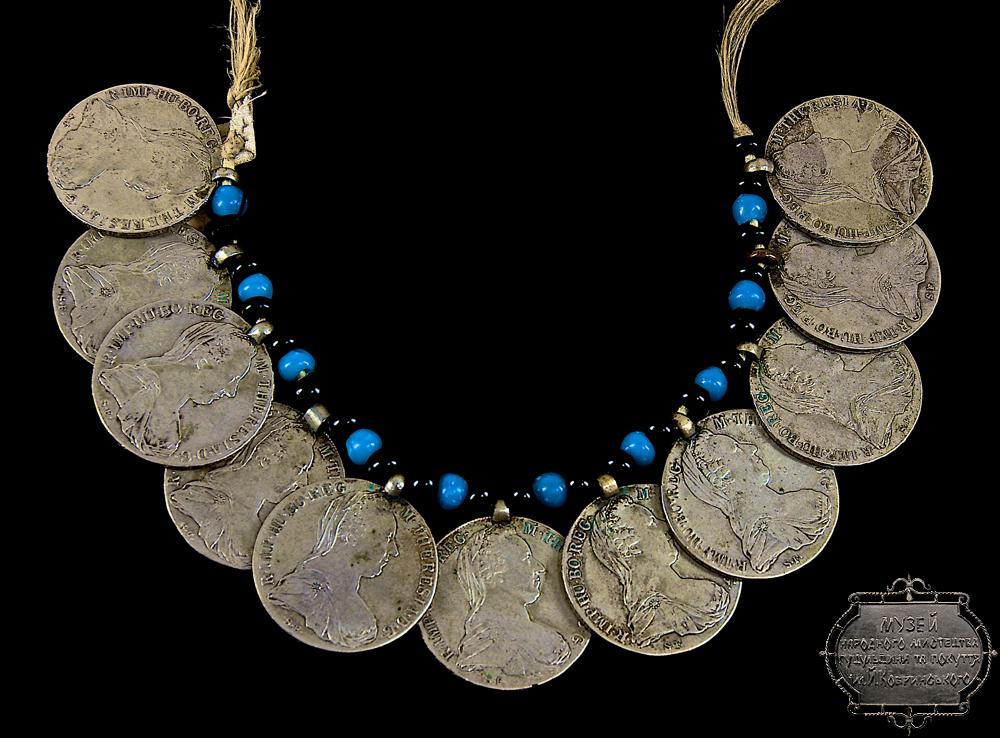
Kniez and kniehynia (Bridegroom and bride). The outfit of newlyweds
The way the Hutsuls dressed up for wedding traces back to very old Ukrainian times and differs from area to area. The only permanent thing is exuberant decoration and vivid colors. Wedding shirts, festive zapaskas, fancy embroidered kozhukh (a Ukrainian jacket) and sardak formed the basis of a bride’s wedding outfit. Multi-tiered neck accessories were completed with a forehead “chiltse”, with thin, ornamented, brassy plates hanging down over the eyes. On the Verkhovyna land, they added a white cape, called “huhlia”, to the wedding outfit of the bride; in Kosiv region, the bride wore a fabulous wreath. A bridegroom put on a white tunic-like linen shirt, wool trousers and shoes, fancy decorated traditional outdoor clothes, and decorated krysania on his head.
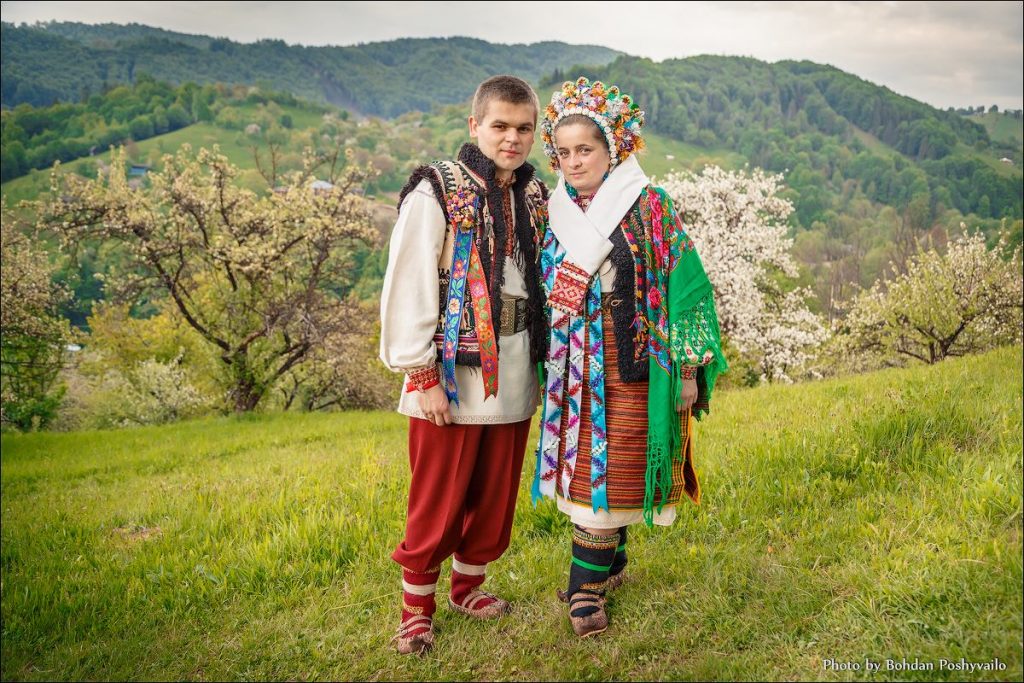
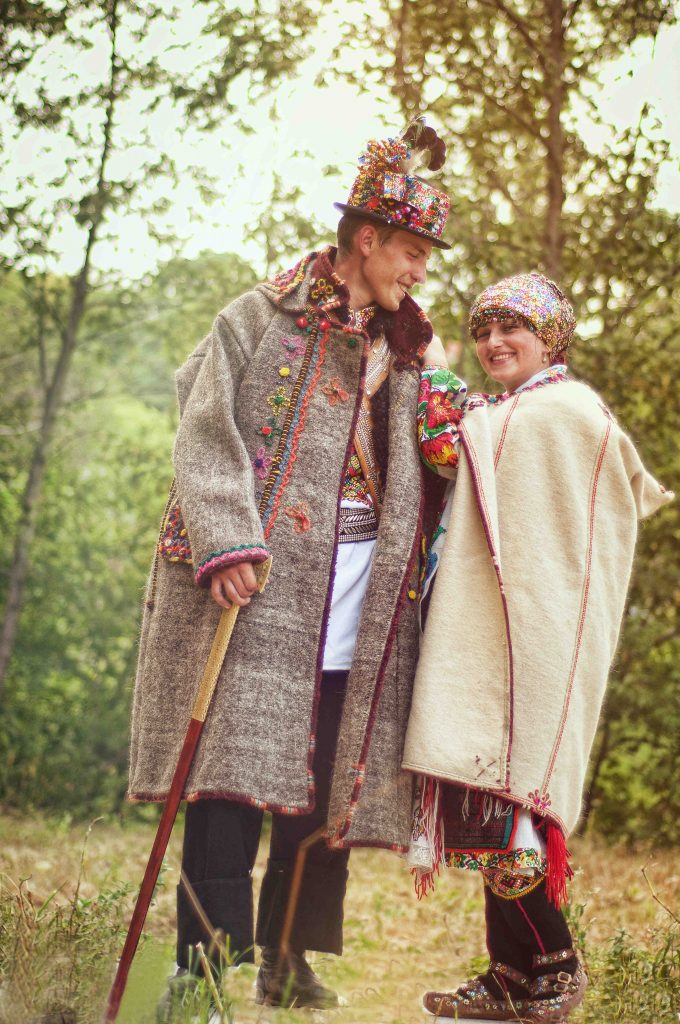
Symbols in Hutsul clothing
The Hutsul attached sacral significance to their clothes. What is more, their outfits served as a sort of protective amulet. Belts and jewels were magically spelled to protect from evil spirits. Kozhukh symbolized fertility and family happiness. Colors in the Hutshul clothing were responsible for significant protective charms as well. Bright festive embroidery reflected light and joy, red symbolized maturity, and protected from fortune-telling, green meant the beginning of growth and black stood for sorrow. Archaic embroidered ornamental motifs could tell a lot about the worldview of the Hutsuls. A meander pattern was the symbol of fertility, a rhombus was the symbol of the Earth Mother and a wave (a water snake) symbolized living water. Meanwhile, a cross pattern represented the sun, and stars stood for faith. Plant motifs told about the harmonious existence of a human being in the wild, and the time-honored, philosophical “tree of life”, embodied the idea of continuous life.
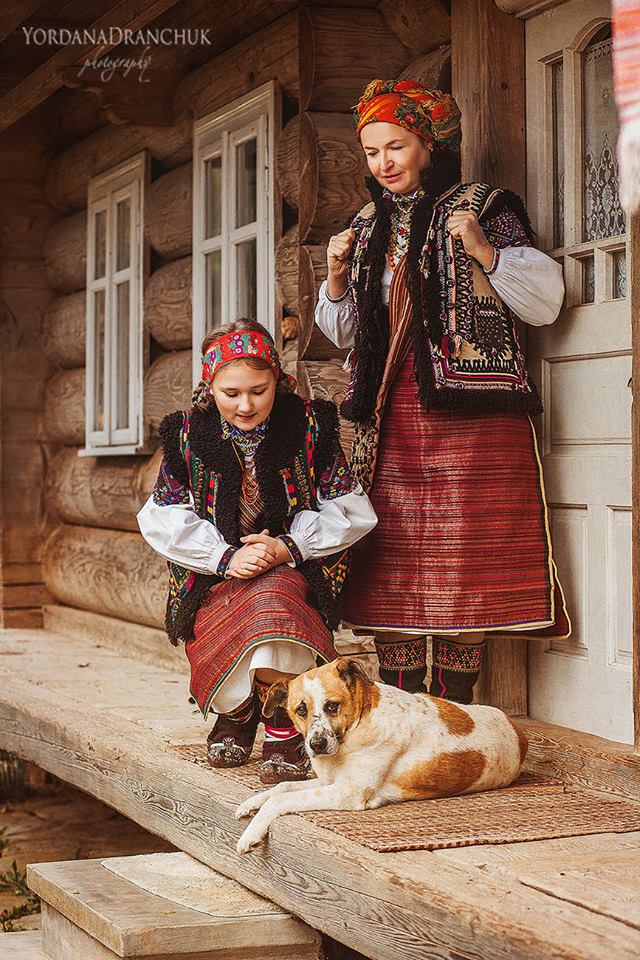
Interesting facts
- Hutsul women used to wear men’s trousers through their pregnancy to deceive the evil eye;
- It was a grave sin for an unmarried woman not to cover her hair;
- A boy from a wealthy family used to wear krysania tipped to one side, and a poor boy had to wear his hat straight;
- Besides the Hutsul land, female jewelry, named zgarda, was also widespread in Georgia;
- Shortly before the wedding, a couple interchanged gifts;
- A bride’s wimple and boots, and a bridegroom’s shirt had to be preserved till the end of their life.
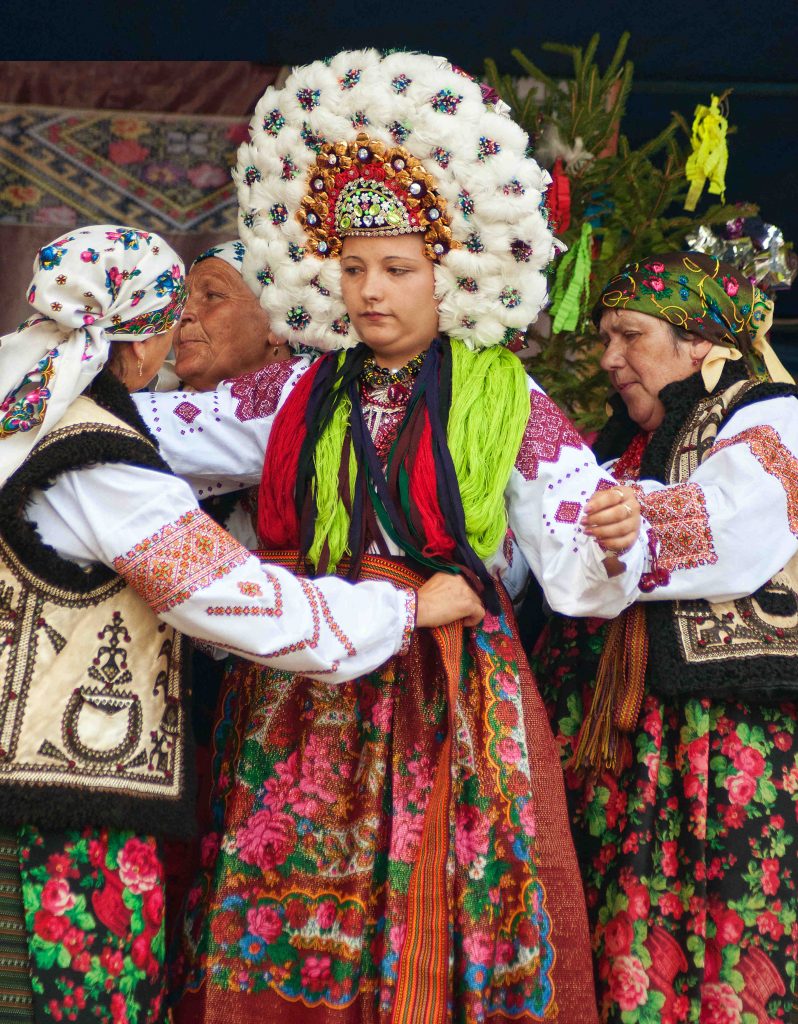
A great number of our tours offer you the opportunity to witness all the exuberance and authenticity of Hutsul clothing. On tours to Carpathians from Lviv such as “The Hutsul Carpathians + Bukovel” and “Around the Carpathians for seven days”, for example, you’ll have a chance, not just to see, but to really get involved with and properly experience life as a Hutsal.
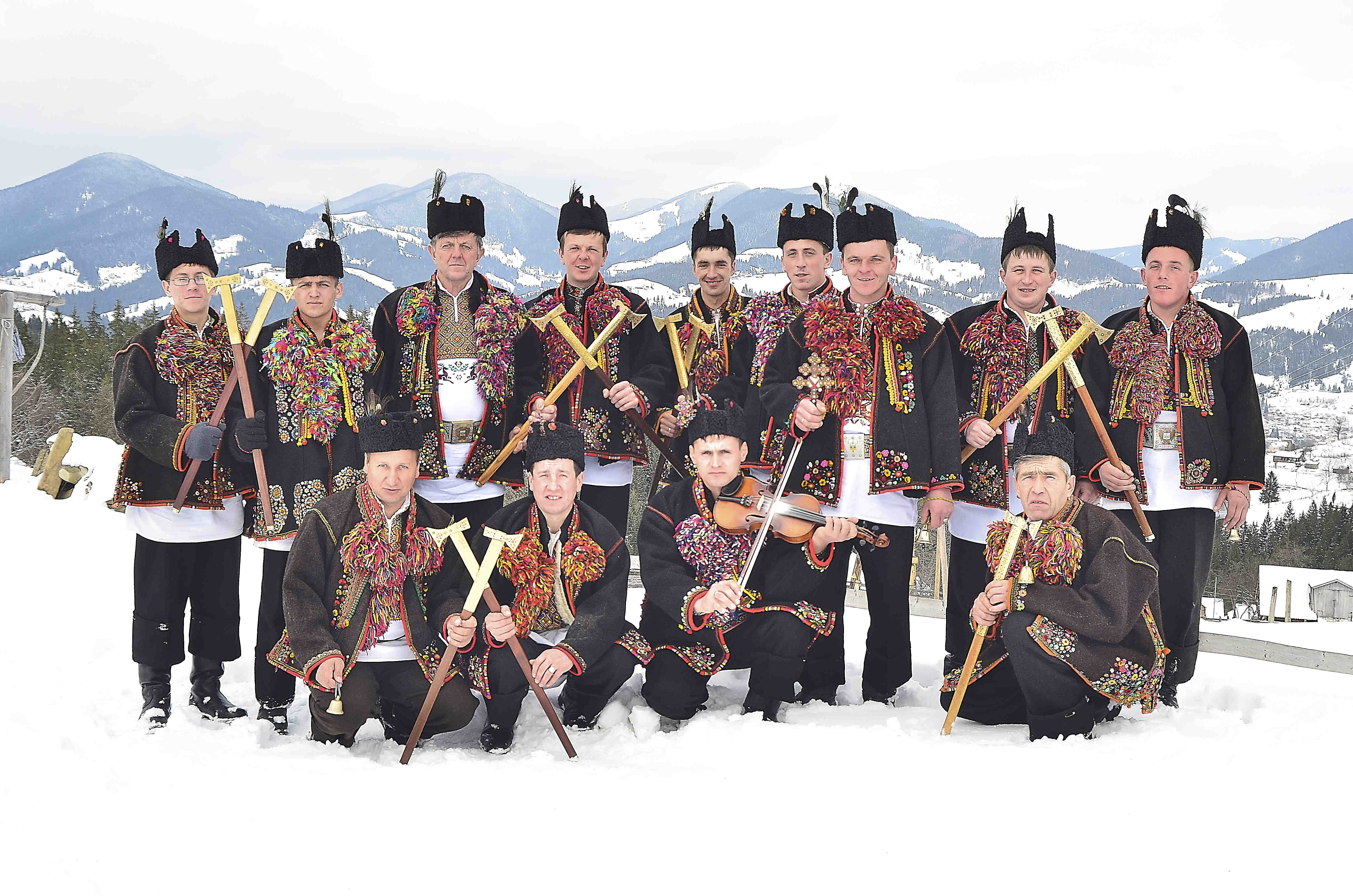
Whenever you are in the Hutsul Land, don’t miss the chance to taste delicious Hutsul dishes too.

